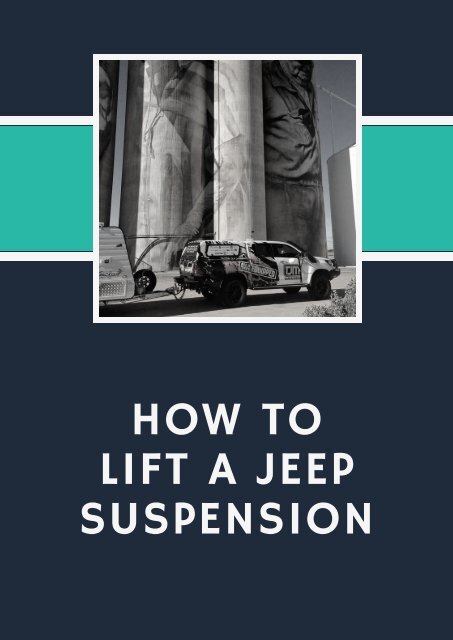HOW TO LIFT A JEEP SUSPENSION
Lift your Jeep to accommodate larger tires and increase approach and departure angles for increased off road capability. It also looks cool. This article is geared towards lifting 1993-1998 (ZJ) Grand Cherokee and 1997-2006 (TJ)Wranglers that have four coil type springs.
Lift your Jeep to accommodate larger tires and increase approach and departure angles for increased off road capability. It also looks cool. This article is geared towards lifting 1993-1998 (ZJ) Grand Cherokee and 1997-2006 (TJ)Wranglers that have four coil type springs.
You also want an ePaper? Increase the reach of your titles
YUMPU automatically turns print PDFs into web optimized ePapers that Google loves.
<strong>HOW</strong> <strong>TO</strong><br />
<strong>LIFT</strong> A <strong>JEEP</strong><br />
<strong>SUSPENSION</strong>
Lift your Jeep to accommodate larger tires and increase approach and<br />
departure angles for increased off road capability. It also looks cool.<br />
This article is geared towards lifting 1993-1998 (ZJ) Grand Cherokee<br />
and 1997-2006 (TJ)Wranglers that have four coil type springs. The<br />
basic principles are the same and could apply to some other models<br />
and makes. Most of all use good judgement and focus on safety when<br />
modifying a vehicle both during the work and considering how the<br />
finished vehicle will handle and drive.<br />
Join a Yahoo Group or similar discussion group of enthusiasts<br />
interested in the same model Jeep as yours. They will be a great<br />
source of encouragement and equipment/method opinions plus be in<br />
a position to help solve the problems you may encounter.<br />
Consider what you are trying to really accomplish. Are you lifting<br />
your daily driver a few inches to accommodate larger tires and<br />
make it more trail worthy or are you building the ultimate trail rig<br />
that you will trailer to events? This is the most important step as it<br />
will dictate what you do during the remaining steps. Think about<br />
the need to get your vehicle inspected, how high of a lift do you<br />
want, what's involved with installing the lift (1-2 is fairly simple not<br />
requiring much; higher and you may need to adjusted/drop other<br />
parts on the vehicle - parts that may not be included in the lift kit),<br />
and most importantly your budget.<br />
Look at various manufacturer's lift kits and prices to decide on the<br />
one that suits you best. The kits will range from a few spacers<br />
costing less than $100 to large groups of parts such as springs,<br />
shocks, track bars, control arms, steering components, extended<br />
brake lines, etc. for several thousand dollars.<br />
Once you have obtained all the parts you need and have secured the<br />
tools and a garage or level driveway surface you are ready to begin.<br />
It is assumed here that you have the mechanical skills and tools to<br />
accomplish the job safely. If you have any doubt about this consider<br />
having your lift kit professionally installed.<br />
Follow the directions that came with the kit! Depending on the<br />
extent and type of kit, the directions will most likely begin with<br />
"support the front end of the vehicle on sturdy jack stands on a level<br />
surface and remove the wheels and tires." This is an essential step<br />
for ensuring your safety during the installation and allows access to<br />
the suspension parts.
Then you will remove the front shock absorbers and coil springs so<br />
they can be replaced with the taller parts. Depending on the kit you<br />
may also replace or modify control arms, brake lines, track bars,<br />
and the Pitman arm steering part. Again stick to the kit<br />
manufacturer's directions as they vary too much to be more specific<br />
here.<br />
The directions will probably have you work the front end first and<br />
then make the rear end mods and possibly add some other mods<br />
involving for instance the transfer case mounts.<br />
After completing the lift installation have someone move the<br />
steering from full left to full right while you inspect the moving<br />
parts for any sign of interference. Solve any problems before<br />
attempting to operate the vehicle.<br />
Install your new tires and wheels. Repeat the left to right steering<br />
test for any signs of interference. Do this both on the ground as well<br />
as with each side jacked up (separately) to maximum suspension<br />
flex to check brake lines and for tire rub on suspension or body<br />
parts.<br />
Lastly go straight to the alignment shop and get a complete front<br />
end alignment. The lifting of a vehicle will change the suspension<br />
geometry and proper alignment is essential for safe operation and<br />
good tire wear.<br />
Now head for the trails! Have fun but be safe and tread lightly to<br />
protect the environment so trails will remain open and Jeepers will<br />
keep their good name.
ARTICLE SOURCE<br />
HTTPS://WWW.WIKI<strong>HOW</strong>.COM<br />
IMAGE SOURCE<br />
HTTPS://WWW.TJMWARRNAMBOOL.COM.AU/




